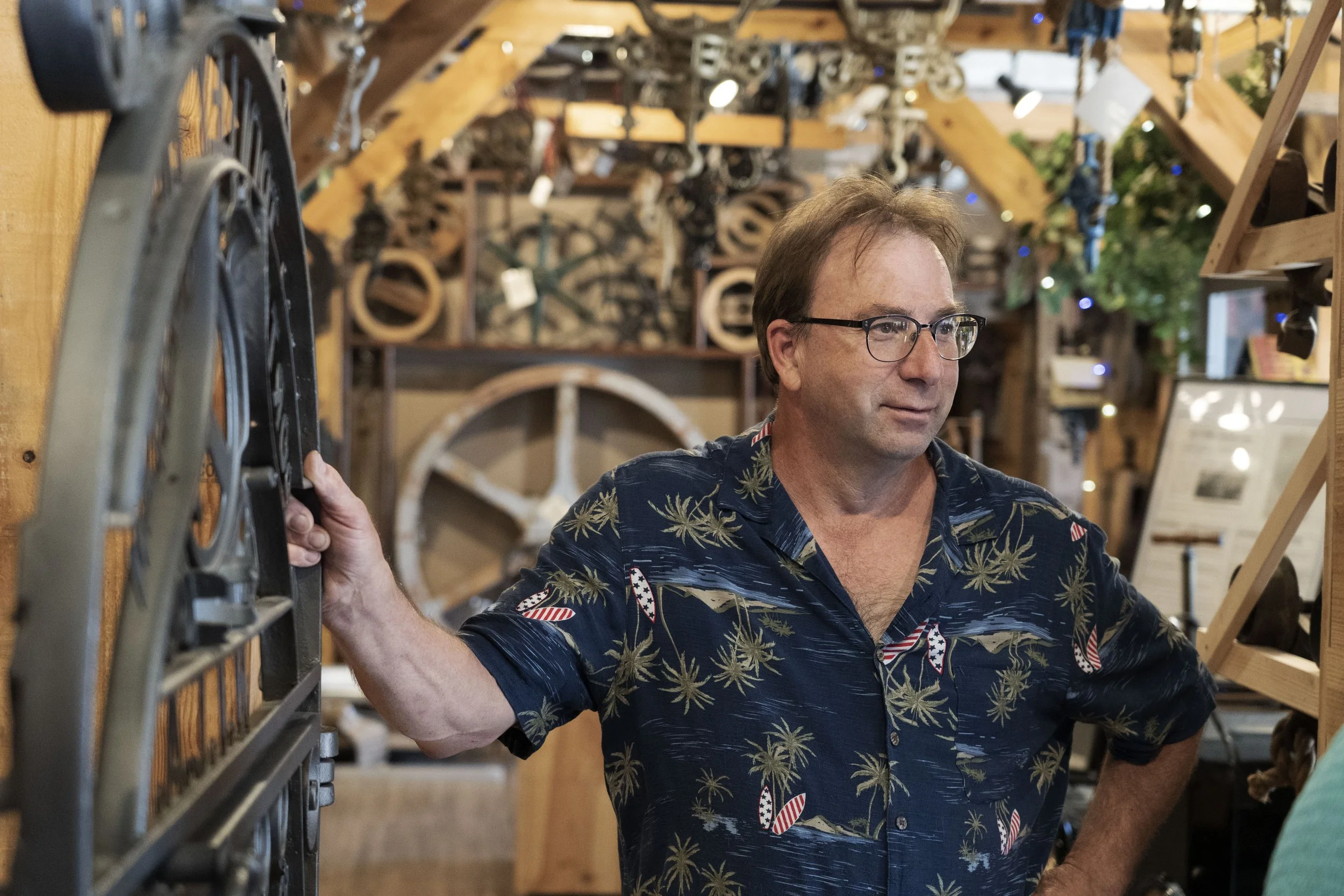The Lewis & Clark Pulley Museum is dedicated to preserving the history and fostering appreciation of early hay farming practices.
It is our mission to collect, restore, document, educate, and display the tools and equipment used by hay farmers in years past. The museum is comprised of a collection of historical hay equipment donated and purchased for this preservation. We would welcome the opportunity to visit local farms and, if interested, discuss possible donations or purchases to add to the museum collection. Items of particular interest to the museum are hay trolleys, hay slings, track, track accessories, pulleys, grapple forks, hay forks, scythes, rope for rigging, and other miscellaneous barn hardware.
The Story Behind Crofton’s “Pulley Man”
A lifelong city boy, Doug de Shazer isn't someone you'd expect to fall in love with farm equipment.
One day, while pushing his daughter's stroller around the flea market, Doug had a chance encounter with a table full of barn pulleys. He picked up one after another, examining them carefully and handling them as if they were glass. As Doug hesitantly left the booth, his friend walked up and gave him a bag. "Happy Father's Day," she said. Inside the bag was a slew of barn pulleys, all different types and colors. Doug was hooked.
The flea market was a three-day affair. All three days Doug stopped by and bought every barn pulley he could find. By the end, instead of his daughter, Doug was pushing a stroller full of pulleys.
One of Doug's friends heard about his newfound interest and invited him to check out something at his shop. Doug arrived and was immediately greeted with another unfamiliar farm contraption—a hay trolley. A bit of research led Doug to the rich history behind hay trolleys and spurred even more curiosity. Now, Doug was really hooked.
16 years and over a thousand barn pulleys later, Doug's obsession turned into one of the largest collection of pulleys and hay trolleys in existence. The current Lewis and Clark Pulley Museum houses every form of pulley imaginable—industrial, construction, barn, ship-made, hand-forged, etc.—in sizes that range from 62 inches to one half-inch in diameter. In addition to pulleys and hay trolleys, the museum boasts a sizable collection of hay forks, harpoons, antique coffee grinders, sleds, wagons, and swings that are also made by hay trolley manufacturers. Another section of the museum houses memorabilia of Crofton, NE dating back to 1900, as well as an original 1925 Ford Model T that was donated by residents of Crofton.
1925 Ford Model T
The car came directly from a Ford Factory in Michigan. The Doctors Coupe Model T was shipped to Crofton by railroad and listed for $520. Its first home was the old Hart Brothers Ford Garage, which was located where the city auditorium now stands. Run by Frank and Lou Hart, the dealership sold and maintained cars in the early days of Crofton.
The car was then purchased by Emil Eliasson on March 3, 1925. The longest trip the car would take during its time with Eliasson, was to Center, Nebraska to be registered. Otherwise, it was strictly to replace a horse and buggy for trips to town from his farm, located 2 miles South of Crofton. Emil then sold it to Ott Bogner in 1945, and it would remain in the family from that moment on. Ott was 30 at the time and the Model T was the first car he had ever owned. He worked for the Nebraska Highway Engineers and drove the car many miles to work and back each day. Later on in his life, he became the owner of a service station in town which he turned into the well-known “Bogner’s” steak house.
Ott retired the Model T in 1955 and it sat in a garage until 1973. Ott then offered to sell the car to his sister and brother-in-law, VK (Bill) and Ramona Maule who were Crofton natives that lived in Scottsdale, Arizona. They took the Model T with them to Arizona, where it remained in storage until 1985. Bill and Ramona then sold it to their son, William (Bill) Maule.
At that time, the car had been in storage, unused, for 49 years, but William and his wife Sherrie began the daunting process of bringing it back to life.
By 1989, the wood frame had been replaced, along with cleaned up tanks and a repaired radiator. William then met Jerry Munday who agreed to take on the long job of frame restoration. Before long, the car was like new.
William and Sherrie have both passed away in recent years, but they left an incredible piece of history behind for the community of Crofton, and a legacy wrapped up in their care for keeping and protecting something that can be enjoyed by generations yet to come.
The Lewis and Clark Pulley Museum is the only one of its kind open to the public. We've seen visitors from all 50 states, as well as Canada, Mexico, Australia, France, Italy, and more.
We offer specialty tours for groups, schools, and other functions upon request. Tours must be booked in advance. To schedule a tour, please click here.
To learn more about hay trolleys and their origins, visit haytrolleyheaven.com, or visit our Facebook page to connect with other enthusiasts and find updates about yearly meetups and community events.








